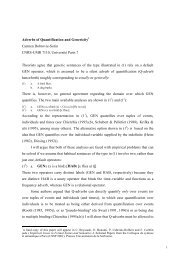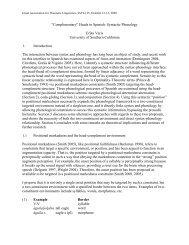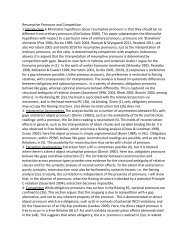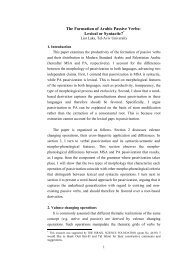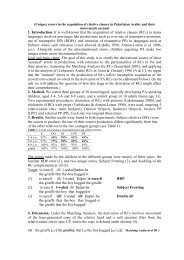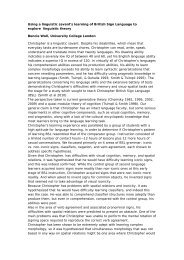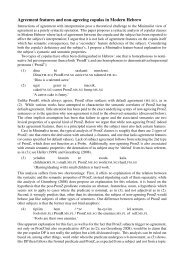paper
paper
paper
You also want an ePaper? Increase the reach of your titles
YUMPU automatically turns print PDFs into web optimized ePapers that Google loves.
¢<br />
¦<br />
As the example in (31) shows, the adjunct like obligatory elements is bound by the subject.<br />
Since adjuncts are not members of the VALENCE list, they are not subject to binding<br />
constraints. Kupsć Marciniak (1996) propose to reformulate the level at which binding<br />
theory is defined in order to widen the scope of the theory. The idea that the binding theory<br />
should account both for adjuncts and circumstantials, i.e. optional constituents, should be<br />
considered as well.<br />
VALENCE attributes are independently included in the VALENCE structure that contains<br />
SUBJ(ECT) and COMP(LEMENT)S. Kupsć Marciniak (1996) omit the SPR attribute since<br />
they analyze specifiers as adjuncts. The subcategorization principle is fulfilled by valence<br />
attributes, whereas ARG–ST remains unaffected and serves mainly as the locus of the<br />
binding theory. Following Pollard Calcagno (1997) and Kupsć Marciniak (1996), I assume<br />
that ARG–ST should not be a list (unlike in Manning Sag (1999)) and that ARG–ST should<br />
have a richer internal structure with attributes of its own. So, I adopt the following structure:<br />
(32)<br />
¡¡¡¡¡¡¡¡¡¡¡¡¡¡¡¡¡¡¡¡¡<br />
¢<br />
category<br />
HEAD head<br />
VALENCE<br />
ARG-ST<br />
¡¡¡¡¡¡¡<br />
valence<br />
SUBJ synsem-list<br />
COMPS<br />
£¥¤¤<br />
list-of-synsems¦<br />
¡¡<br />
¢<br />
arg-st<br />
SUBJ synsem-list<br />
COMPS<br />
£¥¤¤¤¤¤¤¤<br />
list-of-synsems<br />
ADJ list-of-synsems<br />
CIRC list-of-synsems<br />
¦<br />
£¥¤¤¤¤¤¤¤¤¤¤¤¤¤¤¤¤¤¤¤¤¤<br />
The distinction between VAL SUBJ and ARG–ST SUBJ values will be crucial for the<br />
binding theory. The ADJ attribute corresponds to ADJUNCTS that modify NPs, while<br />
CIRC(UMSTANTIAL) represents modifiers of VPs. This distinction is useful since both<br />
(CIRC and ADJ) modify different kinds of phrases. Following Kupsć Marciniak (1996), I<br />
assume that possessives are elements of the ADJ list, i.e. they are treated as adjuncts. 4<br />
The main differences between the binding theory that is adopted and Pollard Sag (1994)<br />
are the following:<br />
(33) (1) This binding theory is based on the property of being a subject and not on the<br />
obliqueness relation; 5<br />
4 Presumably, not all adjuncts will appear at the ARG–ST, but only those that are relevant for binding and<br />
extraction. Since this issue goes beyond the scope of this <strong>paper</strong> and irrelevant for the analysis of comitatives,<br />
I leave it open.<br />
5 Kupsć Marciniak (1996) provide examples that show that the linear order of constituents should also<br />
be taken into account when considering the distribution of personal and possessive pronouns- an additional<br />
piece of evidence that the obliqueness relation is not sufficient.



